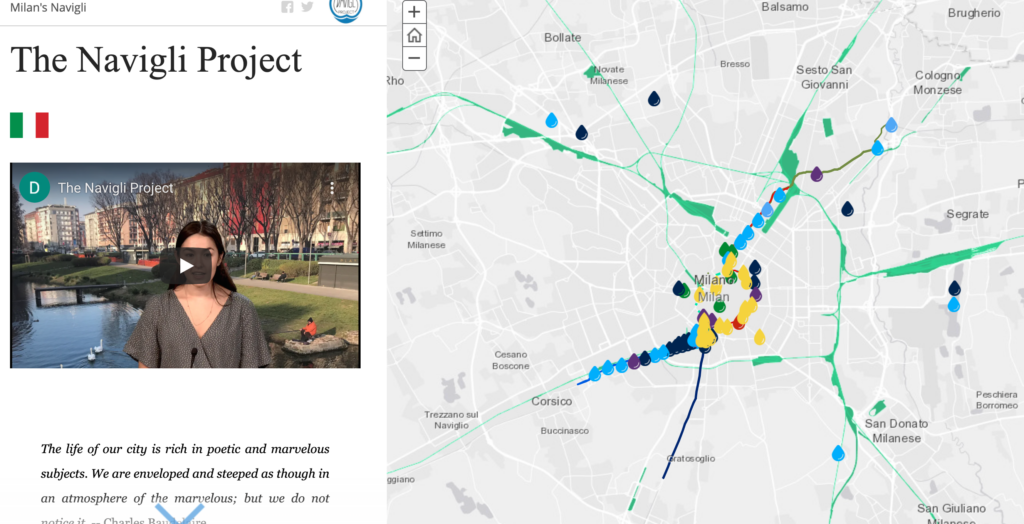Blog post by Serena Ferrando
Navigli Project (http://arcg.is/0vfWKj) is a virtual exhibit that illustrates the cultural history of the waterways of Milan, Italy. Inaugurated in 2016 in the context of an experimental Humanities Lab, this digital mapping project encourages the cultural conservation of water in Milan and promotes water education among its citizens. It includes several layers of history, politics, literature, architecture, sound, video, photography, and geography that show the different factors that throughout the centuries have shaped Milan’s cityscape of today. For more information about Navigli Project, please read below.

Noisemakers! (https://serenaferrando.com/play-maps/) is a multimedia project on noise that utilizes 2D and 3D sound mapping to create a multisensory experience of a geographical place involving hearing and touch in addition to sight. Rooted in advanced music and visual programming software Ableton Live and MaxMSP, it allows users to interact with and remix recorded urban noise/sounds on several digital maps. This project will be reprised in an upcoming spring 2023 Humanities Lab focused on sound and noise. For more information on Noisemakers! and to explore soundmaps, noise instruments, and noise compositions, please visit the website at https://serenaferrando.com/about/

Navigli Project makes the case for ecological digital humanities (ecoDH) as a successful critical, pedagogical, and environmental practice. Grounded in the ecocritical premise that literature and cultural artifacts not only reflect but also shape the way a community relates to its physical environment, Navigli Project constitutes the digital portion of my research on Milan’s water and poetry in the larger field of ecoDH and shows how Navigli Project and analogous DH initiatives transcend the borders of academia by combining literature and technology to support the conservation of environmentally significant areas in the city of Milan. For example, Navigli Project endorses cultural initiatives centered around Milan’s waterways such as those organized by Spazio Alda Merini, a center dedicated to the poet and located near one of the city’s remaining canals.Navigli Project was created in the context of an experimental Humanities Lab in 2016 and complements my book project, Cultural Hydrographies: Water, Poetry, and Environment, by providing a visual and interactive way of discovering and learning about Milan’s aquatic landscape. The exhibit, available both in English and Italian, includes several layers of history, politics, literature, architecture, cartography, sound, film, photography, and geography that show the different factors that throughout the centuries have created Milan’s cityscape today. Building on my experience as a member of the Arizona State University Global Futures Research Accelerator, I plan to expand this digital exhibit with a dedicated smartphone app that will allow tourists and residents of Milan to discover the city’s buried waterways in a multisensory way. The field of ecoDH and of future ecoDH projects such as Navigli Project show great promise within and outside academia since they provide students with a broad set of digital and thinking skills that are easily transferable to other courses, projects, disciplines, careers, and forms of ecological activism; promote the reading of poetry among the younger generations as a way to sustain an openness toward the other-than-human; expand the borders of smaller but by no means marginal academic fields such as Italian studies by embracing transdisciplinarity and environmentalism while remaining deeply rooted in local specificities; and support campaigns for water education and the cultural conservation of water in urban areas. Ultimately, Navigli Project illustrates how digital technology can complement and enhance the power of literature and, specifically, poetry to inspire virtuous relationships between urban citizens and their environment as Navigli Project does in Milan’s case.
Additional resources:
– “The Navigli Project. A Digital Uncovering of Milan’s Aquatic Geographies.” Italian Culture. 37 (2), 2020: 150-158.
– “Water in Milan. A Cultural History of the Navigli.” Interdisciplinary Studies in Literature and Environment (ISLE), 21, 2014: 374-393.
– with Mark Wardecker, “Noisemakers! Putting the Analog in the Digital Humanities.” Humanist Studies & the Digital Age (HS&DA). 6 (1), 2019: 59-68. (First author).
– with Giorgio Sancristoforo, “Audioscan Milano. Exploring Avant-Garde Sound Practices via Digital Humanities.” HS&DA. 5 (1), 2017: 108-115. (First author).
Ferrando’s Powerpoint
https://spark.asu.edu/wp-content/uploads/2022/03/Digital-Projects-Showcase_Slides_Ferrando.pptx
